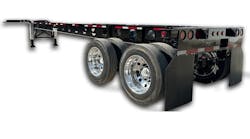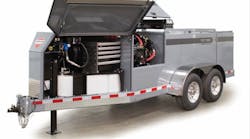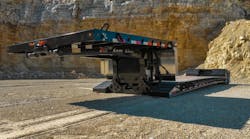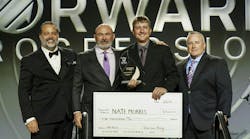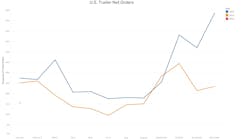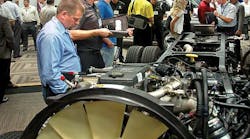THE commercial truck industry was relatively unaffected when the National Highway Traffic Safety Administration and the Environmental Protection Agency introduced the first fuel economy and greenhouse gas emissions regulations for medium and heavy trucks. Of course, that was just Phase 1. Phase 2 is expected to be announced in March—and this time it will be different. Work trucks and truck trailers are both being targeted this time around.
The National Truck Equipment Association has been involved in multiple meetings with representatives from EPA, NHTSA, as well as Environment Canada. The Canadian regulatory agency is working on corresponding rules that are expected to be similar to those that the United States will implement.
The forthcoming regulations can be traced back to a May 2010 memorandum in which President Barak Obama requested administrators of both EPA and NHTSA to “immediately begin work on a joint rulemaking under the Clean Air Act (CAA) and the Energy Independence and Security Act of 2007 (EISA) to establish fuel efficiency and greenhouse gas emissions standards for commercial medium-and heavy-duty on-highway vehicles and work trucks beginning with the 2014 model year (MY).”
The tight timeframe led to the multi-phase rulemaking, says Mike Kastner, NTEA’s government relations director.
“Regulators were tasked with getting Phase 1 out quickly,” he says. “Phase 1 was relatively straightforward for trucks. It set standards for engines. Beyond the chassis manufacturers, it did not have much impact on the commercial truck industry. But as soon as Phase 1 came out—and probably even before—they were working on Phase 2.”
Bob Raybuck, NTEA’s director of technical services, agrees that Phase 2 has more potential to affect truck body manufacturers and truck equipment distributors.
“The main thing our members needed to check was to make sure that trucks were equipped with low-rolling-resistant tires,” he says. “Compliance was mostly on the chassis manufactures.”
What impact is expected?
How will truck equipment distributors and truck body manufacturers be impacted? Specifics will not be known until the notice of proposed rulemaking is published in The Federal Register, but extensive conversations with industry stakeholders have provided insights into how representatives of EPA and NHTSA are thinking.
“We have been on this since the underlying legislation was passed,” Kastner says. “We have had multiple meetings with EPA, NHTSA, and Environment Canada. We have communicated well the industry’s concerns, and we believe we understand their positions.”
One of NTEA’s concerns was that regulators would not fully appreciate the differences between the operating environments of work trucks and that of highway tractors. While tractors and vocational trucks can share the same GVWR class, they are operated in different environments. Those differences have a substantial impact on how effective proposed fuel economy solutions might be. For example, a highway tractor is subjected to aerodynamic drag for hours on end. A straight truck with the same GVW rating but equipped with a digger derrick often operates at speeds so low that aerodynamic devices have no effect on fuel consumption or the emission of greenhouse gases.
“The approach to take for long-haul tractor trailers would be a disaster for the vocational truck industry,” Kastner says. “But we don’t have any indication that the rulemaking is going anywhere but the right direction at this point.”
Certification requirements?
While improved aerodynamics may have less potential for work trucks, upfitters could face restrictions regarding frontal area of the bodies they install.
Raybuck expects the notice of proposed rulemaking will not directly restrict body and equipment installation. Limits probably will come in the form of restrictions from chassis manufacturers.
“The regulators with whom we have spoken have indicated that they generally believe it is everyone’s interest to limit the number of companies being regulated. It’s much easier to require a smaller number of companies to be responsible for complying with a regulation. For instance, they would likely prefer to deal with chassis manufacturers instead of the large number of companies that upfit vehicles.”
So what might be different for work trucks? As has been the case with the series of emissions regulations placed on trucks, Phase 1 set fuel economy requirements for the engines. Phase 2, Kastner believes, could involve more of a systems approach that would include the entire driveline.
Potential opportunities?
Whether this proposal gets folded into Phase 2 remains to be seen, but Kastner believes the potential exists for future fuel economy and greenhouse gas regulations to be a source of business.
“We talked about this before Phase 1 was implemented,” Kastner says. “But many alternative fuel conversions or advanced technology applications presently are being done outside the current regulatory framework. That means that once the truck manufacturer certifies the truck, that’s it. No one gets credit should an upfitter install equipment that reduces greenhouse gas emissions and improves fuel economy. There should be a way to monetize those credits. It’s thinking that’s a little outside box, but it’s not as complicated as it sounds. If someone installs 500-1,000 hybrid systems on trucks that already have been certified, that represents a substantial improvement in fuel economy and a reduction in greenhouse gas emissions. That has value, and no one is getting credit for it right now.
“We believe this issue provides regulators an opportunity to write the rules in such a way that to incentivize these improvements. In the long term, the customer ultimately will have money in his pocket.”
When will it happen?
The presidential memorandum calls for a proposal to be put forth in March, but Kastner received word in early February that the announcement will be delayed, possibly until June.
Once the rules are announced, though, the clock begins to tick. Statutory authority requires a four-year lead time, which would mean that manufacturers would need to comply by 2020. Phase 1, however contained some exemptions that enabled agencies to speed up portions of the mandate.
“We expect much of Phase 2 to be split, too,” Kastner says. “The rule could call for a four-year lead time with an allowance for early compliance in 2018.”
Industry trade associations and individual companies have made their case. The rest is up to the regulators. ♦
_______________________________________________________
NTEA schedules special session for upcoming EPA, NHTSA rule
A representative from the Environmental Protection Agency will be part of a special session at the upcoming Green Truck Summit March 3.
Bill Charmley is the director of EPA’s assessment and standards division. He will be part of a discussion titled “The Impact of Phase Two Greenhouse Gas and Fuel Efficiency Regulations for Trucks.” He will be joined by Alexander Freitag, director of diesel system engineering for Robert Bosch LLC; Michael Hayn, senior field engineer for Bridgestone Americas’ central region; and Brian Mormino, executive director of worldwide environmental strategy and compliance for Cummins Inc.
The Green Truck Summit, sponsored by the National Truck Equipment Association, will be held in conjunction with the association’s annual Work Truck Show March 3-6 at the Indiana Convention Center in Indianapolis.
_______________________________________________________
